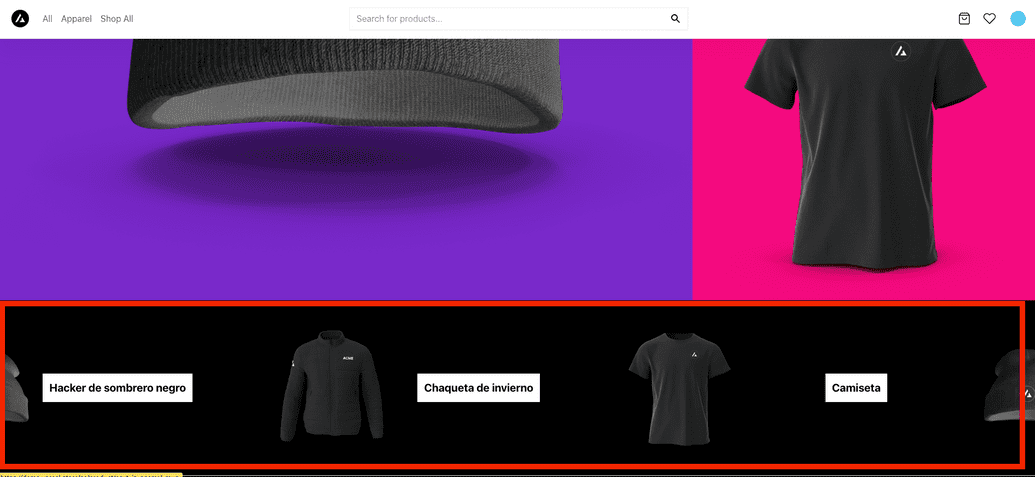Using the Axios plugin to sanitize request data
Sanitizing data with the Axios plugin
If you’re using Axios on your front-end and want to capture the request data inside a replay, you can use the Axios plugin.
However, when that happens, you’ll also expose potential personal information that your front-end might be sending in those requests from your users (like email addresses, bank account information, etc).
That is why you can provide a sanitizer function with the Fetch and the Axios plugins, which would allow you to keep that information from being captured.
Let’s look at how you’d implement a sanitizer for the Axios plugin inside a Next.js project.
The project
For this tutorial, we’ll use this repository for a sample e-commerce site.
The site looks like this:
Notice the red rectangle in that screenshot, for this example, we will replace those products with others, taken from an external API. That request will be done using Axios and the Axios plugin will be used to capture the request data in our replay.
The project setup
This Next.js project will define a Context provider which will enable the rest of the components to access the OpenReplay tracker. You can see more details on how that implementation is done following this OpenReplay + Next.js tutorial.
The context provider, able to use plugins and providing two methods looks like this:
import { createContext } from 'react'import Tracker from '@openreplay/tracker'import { v4 as uuidV4 } from 'uuid'import { useReducer } from 'react'export const TrackerContext = createContext()function defaultGetUserId() {return uuidV4()}function newTracker(config) {const getUserId =config?.userIdEnabled && config?.getUserId? config.getUserId: defaultGetUserIdlet userId = nullconst trackerConfig = {projectKey:config?.projectKey || process.env.NEXT_PUBLIC_OPENREPLAY_PROJECT_KEY,}console.log('Tracker configuration: ')console.log(trackerConfig)const tracker = new Tracker(trackerConfig)if (config?.userIdEnabled) {userId = getUserId()tracker.setUserID(userId)}return tracker}function reducer(state, action) {switch (action.type) {case 'init': {if (!state.tracker) {console.log('Instantiaing the tracker for the first time...')let t = newTracker(state.config)if (state.config.plugins) {state.config.plugins.forEach((p) => {console.log('Using plugin...')t.use(p.fn(p.config))})}return { ...state, tracker: t }}return state}case 'start': {console.log('Starting tracker...')state.tracker.start()return state}}}export default function TrackerProvider({ children, config = {} }) {let [state, dispatch] = useReducer(reducer, { tracker: null, config })let value = {startTracking: () => dispatch({ type: 'start' }),initTracker: () => dispatch({ type: 'init' }),}return (<TrackerContext.Provider value={value}>{children}</TrackerContext.Provider>)}
The key to this context provider, is the 2 functions it provides, the startTracking and the initTracker function. The latter will be called to get the tracker started and it will, in turn, call the use method if plugins are part of the configuration object received by the provider.
Using the Provider
We will be using the above context provider to inject the tracker into all components, so we’ll edit the _app.tsx file like so:
import '@assets/main.css'import '@assets/chrome-bug.css'import 'keen-slider/keen-slider.min.css'import TrackerProvider from '../context/trackerProvider'import { FC, useEffect } from 'react'import type { AppProps } from 'next/app'import { Head } from '@components/common'import { ManagedUIContext } from '@components/ui/context'import trackerAxios from '@openreplay/tracker-axios/cjs'const Noop: FC = ({ children }) => <>{children}</>export default function MyApp({ Component, pageProps }: AppProps) {const Layout = (Component as any).Layout || NoopuseEffect(() => {document.body.classList?.remove('loading')}, [])let plugins = [{fn: trackerAxios,config: {failuresOnly: false,},},]return (<TrackerProvider config={{ plugins }}><Head /><ManagedUIContext><Layout pageProps={pageProps}><Component {...pageProps} /></Layout></ManagedUIContext></TrackerProvider>)}
Currently, the plugin is configured to capture every single request (thus, the failuresOnly property set to false).
Adding the Axios request and getting the Tracker started
For this to work, we’ll get the tracker going from the index.js file and add the function to request the new products inside this file.
The Home component, will now look like this:
export default function Home({products,}: InferGetStaticPropsType<typeof getStaticProps>) {const { initTracker, startTracking } = useContext(TrackerContext)const [makeUpProducts, setMakeUpProducts] = useState<Product[]>([])useEffect(() => {initTracker()async function getProds() {await startTracking()const prods: Product[] = await getMakeUpProducts()setMakeUpProducts(prods)}getProds()}, [])return (/*...*/)}
We’ll use the useEffect hook to trigger this once the page finishes loading. The other important detail to notice here, is the timing between the startTracking function call and the request to the external API.
We would typically have the external request done from the getStaticProps function, but we need this to happen after the Tracker is started, which can only happen from the front-end.
Notice that if you perform the requests with Axios before the tracker calls the start method, they won’t be captured by OpenReplay.
The getMakeUpProducts function does nothing interesting more than a simple Axios request to a public API.
async function getMakeUpProducts(): Promise<Product[]> {console.log('Getting the makeup products')let { data } = await axios.get('https://makeup-api.herokuapp.com/api/v1/products.json?brand=maybelline&apiKey=123fff132')const products: MakeUpProduct[] = datalet newProds: Product[] = products.map((p) => {return {id: '' + p.id,slug: slugify(p.name),name: p.name,description: '',images: [{ url: p.image_link }],variants: [],price: {value: +p.price,},options: [],}})return newProds}
The only thing of note here is the apiKey parameter. For this tutorial, we’ll assume we want to protect the API Key to ensure this information is protected.
Sanitizing the request data
The sanitizer function will be defined as part of the plugin's configuration, so we’ll go back to the _app.tsx file, and add to the plugins variable.
let plugins = [{fn: trackerAxios,config: {failuresOnly: false,sanitiser: (data: RequestResponseData) => {data.url = data.url.replace(/apiKey=([0-9a-z]+)/, 'apiKey=XXXXXX')return data},},},]
The sanitizer simply replaces the URL parameter with a string that hides the actual value. The request itself is sent correctly, but the captured version looks like this:
Thus we’ve successfully hidden the piece of personal information we wanted to hide.
If you’d like to test the code, you can clone this Github repo.
Do you have questions?
If you have any issues setting up the Axios plugin on your project, please reach out to us on our Slack community and ask our devs directly!

